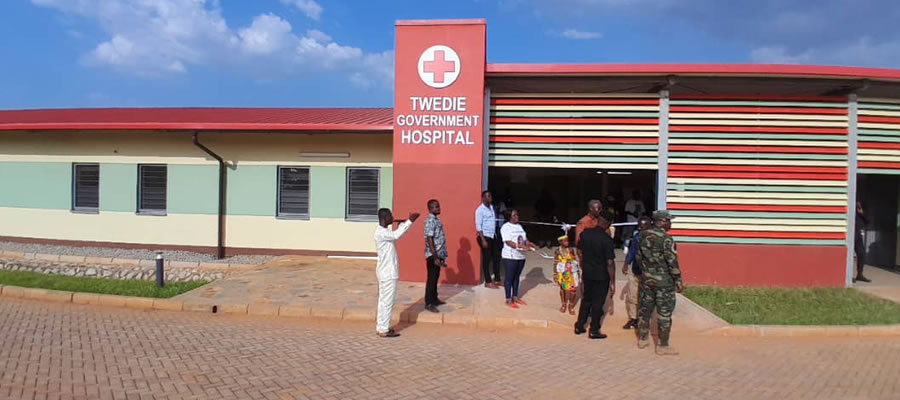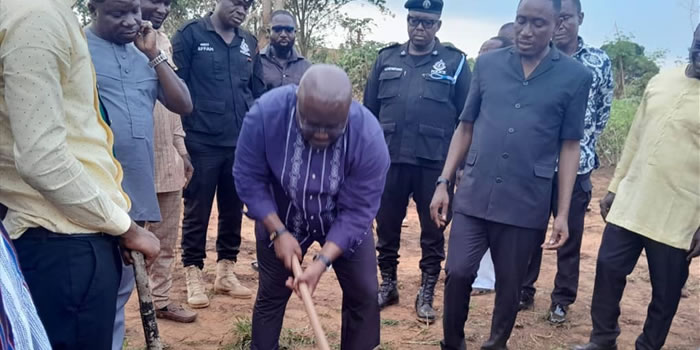

The main types of agricultural activities in the district are farming and livestock rearing. Fishing is also done, but on a very limited scale.
Types of Farming
Crop farming is the principal agricultural activity in the district. The main crops grown in the district are maize, cassava, yam, cocoyam, ginger, oil palm, rice, citrus, cocoa and plantain. A wide range of vegetables like tomatoes, garden eggs, pepper and okra are also grown. Most of these crops are cultivated on small-scale subsistence basis. Only few individuals engage in commercial farming. There are good soils and large farmlands available for the production of these crops on larger scales.
The District can also boast of the presence of large-scale poultry farms. These include Darko Farms, Asare Farms and Mfum Farms. Other small-scale livestock like goats, sheep, pigs, cattle, grass cutter, etc. are also reared. Most of these small-scale livestock rearing activities are meant to supplement nutritional requirements and to earn additional income.
The Atwima Nwabiagya District is one of the leading producers of citrus in the country. Currently, about 12,000 hectares of farmlands devoted to citrus cultivation. Rainfall and climatic conditions favour the cultivation of citrus in the district. Unfortunately, there are no processing facilities to add value to the raw oranges and as a result, producers have to rely on the local market and exports to neighboring countries such as Burkina Faso. These markets are unable to absorb all the supplies of the raw fruits.
The district is also noted for the cultivation of ginger. Despite various initiatives to add value to the crop, not much success has been achieved. For now, all the ginger produced is sold in their raw form. Measures are required to increase production and processing of ginger in the district so as to create and sustain employment.
Other farming activities being carried out in the district, which deserve special attention and promotion, are aquaculture, grasscutter and snail rearing.
Average Farm Size
The average farm size cultivated by a farmer in the district is one (1) acre. The farm sizes are not only small but also scattered, and this affects the application of modern technology, the operation of farms along business lines and the level of production and incomes of the farmers.
Farm Tools
Most farmers in the district still use the cutlass and hoe for their farming activities. The use of agrochemicals is now on the increase to reduce the need for physical labour and time spent in the production process. However, there are only few agrochemical shops currently located in the district. Most farmers travel to Kumasi to purchase their farm inputs. There is therefore the need to promote the sale of these inputs within the district to reduce the cost and time farmers spend to obtain them.
It is also important that whiles the use of Agrochemicals is being promoted on a large scale, the correct application of the chemicals and the required precautions are not compromised, so as to protect our water bodies from pollution and consumers from food contamination.
Land Acquisition
Land in the district could be acquired either through family heads, through lease, personal ownership and tenancy agreement arrangement. As far as the terms of land acquisition are concerned, most of the farmers acquired their land through either sharecropping or lease.
The main types of sharecropping are the “abunnu” (half of the crop produced are given to the tenant farmer and half to the landowner) and “abusa” (two-thirds of the produce is given to the farmer and one-third to the landowner).
These systems have serious implications as agricultural production is concerned. In terms of costs, rates keep on rising in most cases. There is also uncertainty as far as the farmer’s duration on the piece of land is concerned and this blunts incentives among sharecropping and fixed rent tenants. There appears to be little or no innovation as far as the adoption of modern agricultural technology is concerned. Apart from these, land acquisition in the district is generally fraught with litigation and this does not promote increased agricultural production.
Pest and Diseases
Pest and disease condition in the district is not all that serious, apart from the usual caterpillars on vegetables, grass hopers aphids and mites also affect crops. Common diseases are crop drop in citrus and black pods on cocoa. Common pest in animals include ticks, worms and lies. There is the need to control disease and pest infestation to improve yield.
Credit Facilities
The Ministry of Food and Agriculture has credit facility for farmers in the district. Farmers are supplied with credit inputs like seed maize, fertilizers and weedicides to boost up production of maize. About 700 individual farmers benefits from this package. In 2005, 500-acre inputs were supplied to 500 farmers. NGO’s, namely, Self-Help and Heifer Internal Global 2000 are assisting farmers in Seidi, Kobeng, Wioso, Amankyea,Fufuo, Amoaman, Atwima Agogo and Amaduma-Adankwame with credit inputs to increase production. Funds were also made available to farmers under the Food and Agricultural budgetary Support Programme to help farmers expand their farms and reduce poverty.
Other credit facilities like the District Assembly’s Poverty Alleviation Fund, Micro- credit component of the Community Based Rural Development Project etc are available. However, the bureaucratic procedures one has to go through before accessing these credits are often a disincentive to most of the farmers. There is also a general low level of banking culture and poor credit management skills among farmers. All these need to be addressed to enable the framers obtain and effectively utilize credit to increase production and their income levels.
Post Harvest Losses and Storage
Much of the foodstuffs grown by the farmers are lost as a result of poor post harvest practices, notably poor handling, poor storage, poor post harvest management, poor harvesting methods, inadequate market/pricing, lack of credit facilities, high cost of transportation and lack of processing.
The commonly used type of storage facility is the improved ventilated narrow crib, which is extensively used in the maize producing areas. The use of this method has yielded some results. For instance losses for maize have reduced from 45% in 2002 to 30% in 2005.
Most of the other crops are stored using traditional methods, and this is not always efficient. The lack of storage facilities for some of the crops force farmers to sell off their produce at very low prices. This is especially so if there is a bumper harvest and also in the case of citrus and vegetables such as garden eggs and tomatoes which are perishable.
Marketing and Processing
Middle women mainly from Kumasi and Abuakwa play an important role in the marketing of agricultural produce in the district. Most of the farmers sell their produce to the middle women and men on market days. They in turn sell them at urban markets within and outside the district. However, these middlemen dictate the prices of the agricultural produce. In most cases the prices are unfavorable to the farmers. Even though Farmers complained about this situation, they have no alternative, since most of the items they produce are perishable, coupled with the fact that most of the produce are sold in their raw state.
Fishing and Aquaculture
There is freshwater fishing within the district at Mfensi. Both male and females are engaged in this type of occupation. Whilst the males are directly involved in fishing, the females are mainly fishmongers. Fish farming has not received much attention in the district even though it has great potential. There are only 20 individual fish ponds in the district covering a total land area of about 12 hectares. Most of the ponds are not active and therefore need to be re-activated. The ministry of fisheries has 5 large ponds at Nkawie. However, it is being under-utilized and any form of support that will see the re-vamp of the ponds is welcome.
Extension Services
There are eleven (11) Agriculture Extension Agents in the district as against 32 required. The extension agent to farmer ratio in the district is 1: 3,000. This is woefully inadequate compared with the ideal ratio of 1:1,500, and the national ratio of 1: 1,670. Most farmers, especially those in Wurapong, Boahenkwa, Ntabaanu and Nyamebekyere areas are not adequately covered by extension services. Measures are required to improve upon the district’s ratio, if farmers are to get the right level of technology and at the right time to enable them improve upon their production and income levels.
Even more critical, is the need to improve the working conditions of the existing extension staff especially in terms of transport, skills and accommodation to enable them give out their best.
Date Created : 11/24/2017 5:38:07 AM












 facebook
facebook
 twitter
twitter
 Youtube
Youtube
 +233 593 831 280
+233 593 831 280 0800 430 430
0800 430 430 GPS: GE-231-4383
GPS: GE-231-4383 info@ghanadistricts.com
info@ghanadistricts.com Box GP1044, Accra, Ghana
Box GP1044, Accra, Ghana